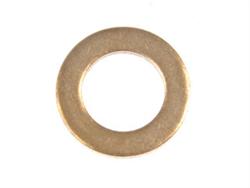Your correct... thanks for jogging my brain, when apart use a tooth pic or some thing to measure the depth of the caliper threads and compare that to the hose end... may have a parts mismatch. If the hose threads are too long you might cure this by filing off a tiny amount of material from the hose, a thicker sealing ring could do it too, but yours looked to be pretty thick. Whatever the case, you are very close so your problem is going to be some thing really small. If the threads look to have good depth, just try new rings first.
While fooling around with this that hose will want to drip all of the fluid away... find some rubber caps that fit snug or a small piece of hose and plug the end... it will save you having to bleed an empty master cylinder circuit.



















